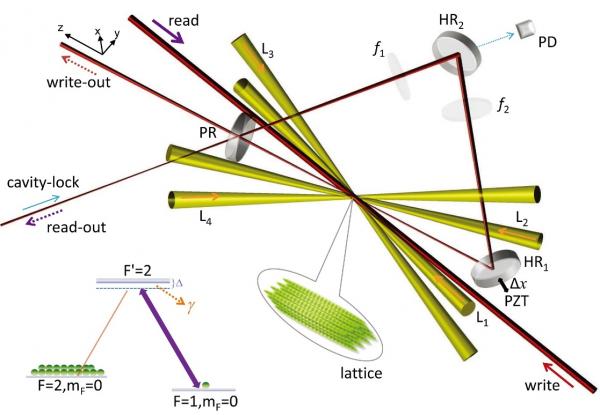China realizes 100-millisecond quantum memory for the first time
Pan Jianwei and Bao Xiaohui from the University of Science and Technology of China have used the cold atomic ensemble for the first time to realize a hundred millisecond high-efficiency quantum memory, which has laid a solid foundation for the construction of a long-distance quantum relay system. The results were published on the 31st of May in the international authoritative academic journal Natural Photonics. The reviewers gave high recognition to the importance of this work and praised the experiment as "extraordinary tour de force". Quantum relays can solve the major problem of exponential attenuation of photonic signals in optical fibers. It is one of the important ways to realize ultra-long-distance quantum communication in the future.
Quantum communication is considered as an absolutely secure communication method. Its basic principle is to use a single photon to encrypt information carrying a qubit to transmit. At present, quantum communication can only reach the order of 100 kilometers. To realize long-range quantum communication above 1000 kilometers, quantum relay technology based on quantum storage is needed.

Experimental device schematic
The quantum relay scheme that has been implemented before this, the time that it takes long-range to send one quantum bit of information is on the order of minute above. The basic principle of quantum relay is to use the combination of segmented entanglement distribution and entanglement exchange to expand the communication distance. The core is the quantum storage technology. By caching the photon bits, the entanglement connection efficiency can be greatly improved. In order to meet the actual requirements of the long-distance quantum relay, the quantum memory needs to store the single quantum state for a long time and has high read efficiency.
In recent years, experimental research on quantum storage has progressed rapidly, but so far, no system has been able to meet quantum relay needs in both storage time and efficiency.
Cold atomic ensemble is an important physical system for quantum storage experimental research. Its main advantages include abundant manipulation means and simple decoherence mechanism.
In order to further improve storage time, Pan Jianwei's team has developed a number of key experimental techniques such as the three-dimensional optical lattice limiting atomic motion in recent years. This has led to a significant suppression of decoherence caused by atomic motion, and finally achieved a storage life of 0.22 seconds. 76% efficient quantum memory. Compared with the 2012 work, this experimental result has improved storage life by nearly two orders of magnitude.
The significance of this experiment is that, for the first time, the storage life and readout efficiency are increased to meet the actual needs of long-distance quantum relays. It has been estimated that this result, combined with technologies such as multi-mode storage and high-efficiency communication band interfaces, can theoretically support the implementation of quantum-tunnel relay over 500 km of entanglement and surpass the limit of direct optical fiber transmission.
The research work was supported by the Chinese Academy of Sciences Quantum Information and Advanced Technology Center for Quantum Science and Innovation, the Chinese Academy of Sciences-Alibaba Quantum Computing Laboratory, the Funding Committee, the Ministry of Science and Technology, and the Ministry of Education.
Related research progress
In 2012, Pan Jianwei, Bao Xiaohui, and others first realized millisecond-class high-efficiency quantum memory, but this storage time is still far from the actual demand for long-distance quantum relays.
In May 2012, Li Chuanfeng's research group led by Guo Guangcan, academician of the Chinese Academy of Sciences and professor of the China University of Science and Technology, realized the quantum memory of single-photon polarization for the first time in a solid-state system. The fidelity was 99.9%, setting a new world record.
In 2013, the world’s first quantum memory that can store single-photon shapes was born in China.
In August 2015, Li Chuanfeng's research group successfully developed high-dimensional solid-state quantum memory for the first time.
In October 2015, Li Chuanfeng’s research team successfully implemented deterministic, single-photon, multi-mode solid-state quantum storage, which can store 100 qubits at a time and create the highest level in the world.
Running Man Exit Sign,Running Man Sign,Green Running Man Exit Sign,Running Man Emergency Light
NINGBO JIMING ELECTRIC APPLIANCE CO., LTD. , https://www.jimingemergencylight.com